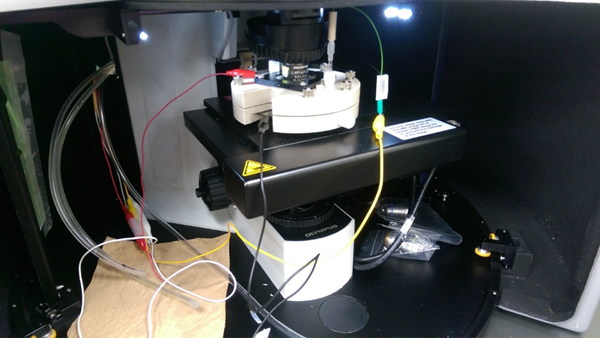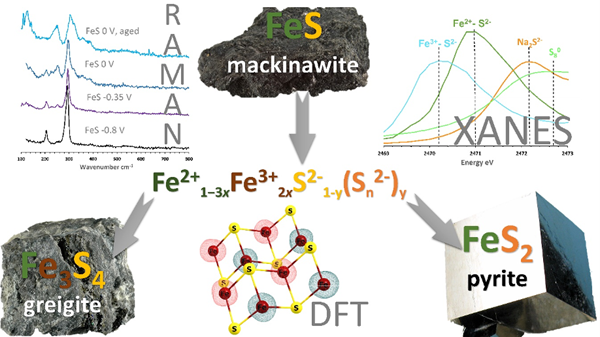Iron sulfide minerals may have supported multiple redox conversions necessary for the origin of life. To fully discover the catalytic potential of iron sulfide minerals, a greater understanding of the electrochemical properties (the electron flow to and from iron and sulfur) and the interconversion of different structural forms of iron sulfide is necessary. A research team lead by ELSI PI Shawn McGlynn discovered a unique iron sulfide phase occurring transiently during iron sulfide maturation. This finding helps to understand how minerals form, how electrons may have flowed during early catalysis and gives us new insight into using these materials as low-cost catalysts in industrial processes.

Iron sulfide minerals can be found abundantly on Earth. Pyrite (also known as fool’s gold) can be collected leisurely on a hike from sedimentary rock. Iron sulfide minerals are also inferred to be abundant on the early Earth. They are hypothesised to have jump-started the origin of life by allowing chemical reactions to occur faster than otherwise. One crucial requirement for these reactions is the electronic inter-conversion of organic molecules – which is required to fill or complete a metabolism. Iron sulfide minerals can catalyse (accelerate) the reaction of these compounds to generate organic acids from CO2, for example. These organic molecules can then react with NH3 (generated from NO3- or N2, for example) to produce amino acids, the building blocks of proteins and cells. But depending on which iron sulfide mineral is present, some of these biochemical reactions might have occurred more easily than others, or not at all.
On early Earth, which had an atmosphere nearly devoid of oxygen, pyrite might not have been the most common iron sulfide mineral. ELSI researchers led by Prof. McGlynn aimed to understand which minerals may have formed first before pyrite. The research – conducted by PhD candidate Sebastian Sanden started from Fe2+S (known as mackinawite) – a reactive precursor to other iron sulfide minerals. While this question had been approached before, Sanden et al. used a system where electrons were directly taken up by an electrode upon application of an electric potential. This allowed the group to study the loss of electrons under tightly controlled conditions and investigate the resulting materials via spectroscopic techniques.

One of the major findings was that upon oxidation of iron sulfide, a previously uncharacterised intermediate was generated, which surprisingly contained both Fe3+ and S1-. Because both iron and sulfide lacked 1 electron (after applying a defined electric potential), the mineral phase appears to be en route to greigite or pyrite, or both, which are constituted by Fe3+ and S1- respectively. This newly described intermediate has yet unknown catalytic properties, which might combine desirable properties of both greigite and pyrite. Furthermore, this new oxidised intermediate may allow for selective formation of greigite or pyrite, and perhaps even an FeS based redox cycle to take place, something which could be useful in the birth of metabolism.
Since iron and sulfur are in-expensive compared to noble metals such as platinum, they might be utilised as sustainable catalysts in industrial processes in the future. Nature also chose metal sulfides (i.e. iron-nickel-sulfide clusters) as the active centre of enzymes facilitating H2 generation or CO2 reduction. Thus, the work by Sanden et al. could potentially be improved by mimicking catalytic centres of enzymes. Similar processes might have also occurred during the origin and evolution of life. The search for environmentally friendly industrial catalysts, and the retracing the function of iron sulfide catalysts at the origin of life, are two interrelated goals with much more room for cross-fertilisation.
| Journal | Dalton Transactions |
| Tile of the paper | Electrochemically induced metal-vs. ligand-based redox changes in mackinawite: identification of a Fe3+-and polysulfide-containing intermediate |
| Authors | Sebastian A. Sanden*a,b, Robert K. Szilagyi*c, Yamei Li a, Norio Kitadaid, Samuel M. Webbe, Takaaki Yanof, Ryuhei Nakamuraa,g, Masahiko Haraa,b, Shawn E. McGlynn*a,g,h |
| Affiliations | a. Earth- Life Science Institute, Tokyo Institute of Technology, 2-21-1 IE-1 Ookayama, Meguro, Tokyo 152-8550, Japan. b. School of Materials and Chemical Technology, Tokyo Institute of Technology, 4259 G1-7 Nagatsuta, Midori-ku, Yokohama, Kanagawa 226-8502, Japan c. Department of Chemistry and Biochemistry, Montana State University, Bozeman, MT 59717, USA. d. Super-cutting-edge Grand and Advanced Research (SUGAR) Program, Institute for Extra-cutting edge Science and Technology Avant-garde Research (X-star), Japan Agency for Marine-Earth Science and Technology (JAMSTEC), 2-15 Natsushima-cho, Yokosuka 237-0061, Japan e. Stanford Synchrotron Radiation Lightsource, SLAC National Accelerator Laboratory, 2575 Sand Hill Road, Menlo Park, CA 94025, USA f. Institute of Post-LED Photonics, Tokushima University, Minami-Jyosanjima, Tokushima 770-8506, Japan g. Center for Sustainable Resource Science, RIKEN, 2-1 Hirosawa,. Wako, Saitama 351-0198, Japan h. Blue Marble Space Institute of Science, Seattle, Washington 98154, USA |
| DOI | 10.1039/D1DT01684A |
| Online published date | 23 July, 2021 |
